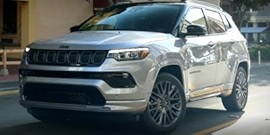Jeep Compass tire size
When it comes to choosing a proper Jeep Compass tire size, you should always specify the right year of manufacture.
Browsing Jeep Compass tire sizes you might have noticed that some editions have interchangeable wheels while others do not fit. It often happens that car manufactures change model’s tire size measurements across years. We have structured the wheel data so that you could find out Jeep Compass models with the same tire size.
Scroll down to the bottom of the page to see how tire size range changed within Jeep Compass family across years.
 BFGoodrich
Advantage T/A Sport (T-Speed Rated)
BFGoodrich
Advantage T/A Sport (T-Speed Rated)
 General
AltiMAX RT43 (T-Speed Rated)
General
AltiMAX RT43 (T-Speed Rated)
 Cooper
Evolution Tour
Cooper
Evolution Tour
 Cooper
Cs5 Grand Touring
Cooper
Cs5 Grand Touring
Jeep Compass tire size by years
By clicking the link below you will be redirected to Amazon website, Tires Department.
Reference
jeepcompassca.com:
2022
2021
2020
2019
2018
2017
2016
2015
2014
2013
2012
2011
2010
2009
2008
2007
Tire Fitment
-

Dually Tire Sizes And Peculiarities
Dually tires are an interesting ally of automotive engineering. Not only do they help provide more stability to heavy-duty vehicles, but the two sets of tires also give your ride a rugged look that...







Discussion